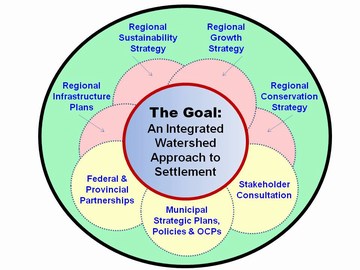Sustainable Service Delivery: ‘Design with Nature’, Protect Stream Stability, and Save Money
Note to Reader:
The initial capital cost of municipal infrastructure is about 20% of the life-cycle cost; the other 80% largely represents a future unfunded liability. Each year, the funding shortfall grows. Fiscal constraints provide a driver for a change in the way local governments plan, finance, implement and over time replace infrastructure.
Through a program of professional development, the four Comox Valley local governments are striving for a consistent regional approach to Sustainable Service Delivery. The focus of the 2011 Seminar Series is on how all those involved in land development have a role to play.
In April, Seminar #1 painted a picture of the ‘legacy liability’ of existing hard infrastructure (i.e. roads, water, sewers).
On May 19, Seminar #2 will deal with green infrastructure and ‘sustainable urban drainage’. Jim Dumont will explain the water balance methodology and demonstrate how to establish performance targets for rainfall capture. A town-hall sharing session will then explore how to implement green infrastructure in Northeast Comox to protect the agricultural lowlands.
To download a PDF document version of the article below, click on Sustainable Service Delivery: Design with Nature, Protect Stream Stability, and Save Money
Agenda Overview for Seminar #2 about Adaption – ‘Design with Nature’ to Achieve Rainfall Capture and Water Conservation Goals
The focus of Seminar #2 is on urban watershed protection and restoration issues, with emphasis on a ‘design with nature’ approach to climate change adaptation:
- These are the values of importance to everyone; and this is the community standard that we wish to build to.
A desired outcome is that participants will understand how a ‘design with nature’ approach integrates rainwater management and drought management.
Design with Nature
In British Columbia, a provincial goal is to advance this ‘new business as usual’: settlement change that is in balance with ecology. Commencing in 2003, consistent and repeated use of the phrase ‘design with nature’ has proven effective in facilitating a paradigm-shift in the local government setting.
 The phrase is borrowed from the title of a seminal book by Ian McHarg, published in 1969. He was a renowned landscape architect and writer on regional planning using natural systems. His book Design with Nature pioneered the concept of ecological planning. Ian McHarg’s premise is simple: “that the shaping of land for human use ought to be based on an understanding of natural process.”
The phrase is borrowed from the title of a seminal book by Ian McHarg, published in 1969. He was a renowned landscape architect and writer on regional planning using natural systems. His book Design with Nature pioneered the concept of ecological planning. Ian McHarg’s premise is simple: “that the shaping of land for human use ought to be based on an understanding of natural process.”
His philosophy was rooted in an ecological sensibility that accepted the interwoven worlds of the human and the natural, and sought to more fully and intelligently design human environments in concert with the conditions of setting, climate and environment.
Adaptation and Collaboration
 “Designing with nature captures the essence of climate change adaptation. Adaptation is about responding to the changes that will inevitably occur. Adaptation is at the community level and is therefore about collaboration,” states Raymond Fung, Chair of the Green Infrastructure Partnership, in a quote published in Beyond the Guidebook 2010: Implementing a New Culture for Urban Watershed Protection and Restoration in British Columbia.
“Designing with nature captures the essence of climate change adaptation. Adaptation is about responding to the changes that will inevitably occur. Adaptation is at the community level and is therefore about collaboration,” states Raymond Fung, Chair of the Green Infrastructure Partnership, in a quote published in Beyond the Guidebook 2010: Implementing a New Culture for Urban Watershed Protection and Restoration in British Columbia.
“In May 2005, the Green Infrastructure Partnership developed a branding graphic to define ‘designing with nature’ in contemporary terms. We essentially adapted Smart Growth principles, albeit in action-oriented sound-bites. The catalyst for developing this mind-map was a consultation workshop with the Metro Vancouver Regional Engineers Advisory Committee.”
Infrastructure Liability:
The ‘design with nature’ branding graphic has evolved over the past six years. In 2011, the infrastructure liability issue was weaved into the storyline (see below). There are two dimensions to the goal of a ‘lighter water footprint’, namely: reduce water use to ensure sustainability of supply; and reduce drainage runoff to protect stream stability.
Rainwater Management in a Watershed Context: Shifting from Gray to Green
Seminar #2 is structured in two parts as shown in the Agenda. In the morning, the unifying theme is “Look Beyond Our Municipal Boundaries”. The focus is on aligning efforts at a watershed scale to ‘design with nature’, protect stream stability, and save money.
In the afternoon, the theme is “Look Within Our Boundaries” because the spotlight shifts to the Northeast Comox case study and implementation of green infrastructure to achieve a ‘lighter water footprint’. Participants will find that each part informs the other.
Look Beyond Our Boundaries
 Glenn Westendorp, Chair of the 2011 Series, will introduce the inter-municipal Brooklyn Creek case study. In 1999, the estimated $1.8 million cost for creek stabilization and restoration was well beyond the financial capacity of the Town of Comox; and was the driver for doing business differently. This case study provides a graphic illustration of an infrastructure liability that is the consequence of NOT designing with nature.
Glenn Westendorp, Chair of the 2011 Series, will introduce the inter-municipal Brooklyn Creek case study. In 1999, the estimated $1.8 million cost for creek stabilization and restoration was well beyond the financial capacity of the Town of Comox; and was the driver for doing business differently. This case study provides a graphic illustration of an infrastructure liability that is the consequence of NOT designing with nature.
Nature Without Borders:
Brooklyn Creek will provide the springboard for a co-presentation by Jack Minard (Comox Valley Land Trust) and Kevin Lorette (Comox Valley Regional District). They will speak to the loss of baseflow (i.e. “too little water”) and the impact on stream health
Jack Minard and Kevin Lorette will introduce the Tsolum River case study that will be featured in Seminar #3; and they will refresh the vision for An Integrated Watershed Approach to Settlement. This was an outcome of the 2009 Series.
They will also connect the dots between land use practices and water balance management. This will provide a segue to the “course within a seminar” that Jim Dumont will deliver.

Sustainable Urban Drainage:
“The need to embrace green infrastructure practices arose from the requirement to prevent further increases in damage to both the environment and the agricultural community resulting from the increase in rainwater runoff from urban areas,” states Jim Dumont, Engineering Applications Authority for the Water Balance Model Partnership.
 “Stream health is the elephant in the room. As the Brooklyn Creek case study illustrates, where will a municipality find the money when it has to go back in to fix a destabilized stream? From the municipal perspective, the objective should be to prevent what you are allowing now from costing you more in the future.”
“Stream health is the elephant in the room. As the Brooklyn Creek case study illustrates, where will a municipality find the money when it has to go back in to fix a destabilized stream? From the municipal perspective, the objective should be to prevent what you are allowing now from costing you more in the future.”
In a two-hour timeframe, Jim Dumont will deliver a mini-course that introduces the history, science and tools of Rainwater Management. He will:
- Provide background on “myths and misconceptions”
- Connect the dots to Sustainable Service Delivery as defined at Seminar #1
- Distinguish between BLUE solutions and GREEN solutions
- Explain why ‘green solutions’ can save money and create legacy benefits over time
- Explain watershed targets and how to establish them to achieve tangible objectives
- Explain how watershed targets can be met at the development and site scales
- Introduce practical screening tools that enable local governments to ‘do more with less’
The mini-course informs the rationale for an inter-governmental approach to rainwater management in a watershed context, and is relevant to all land development proposed in the Comox Valley. It is especially applicable to tributary and/or small streams because they are most vulnerable to stream health impacts (e.g. as demonstrated by Brooklyn Creek).
To Learn More: For additional context, the reader is referred to Green Infrastructure: Achieve More With Less, published in Construction Business Magazine in February 2011.
Look Within Our Boundaries
In the afternoon session, two short presentations will provide context for a town-hall sharing session on a real-world case study, namely Northeast Comox. The purpose of the town-hall session is to provide the Town of Comox with a feedback loop for application of the ‘green’ approach described in the morning.
Sustainable Service Delivery:
There are three dimensions to the infrastructure liability issue, with key objectives for a Sustainable Service Delivery approach synthesized as follows:
- Pay down the legacy cost of existing hard infrastructure (water & sewer).
- Reduce the life-cycle cost of new hard infrastructure.
- Shift from gray to green to protect downstream values (i.e. environmental and/or agricultural).
The emphasis in presenting the Northeast Comox case study is on dimension #3.
Changes to Built Environment in NE Comox:
Tim Pringle will examine NE Comox through the lens of the Comparative Land Use Typologies & Matrix. He showcased this evaluation tool during the 2009 Series. It can be used to determine the acceptability of developer proposals for large-scale real estate development.
 Tim Pringle will explain where NE Comox development fits into the Comox Valley big picture; and he will offer his observations about integration of ‘design with nature’ principles so that pending development projects keep the natural hydrology intact. He is the President of the Partnership for Water Sustainability in BC.
Tim Pringle will explain where NE Comox development fits into the Comox Valley big picture; and he will offer his observations about integration of ‘design with nature’ principles so that pending development projects keep the natural hydrology intact. He is the President of the Partnership for Water Sustainability in BC.
“At the conclusion of my presentation,” states Tim Pringle, “my hope is that the audience will have an appreciation for what this equation means: Changes in NE Comox = Potential Assets and Liabilities (Infrastructure Deficit or Gain?).”
Hierarchy of ‘Green’ Vocabulary:
To develop a common understanding plus help advance a new way-of-thinking about land development, Tim Pringle co-developed the following hierarchy of ‘green’ vocabulary:
- Green Valuemeans land use strategies will accommodate settlement needs in practical ways while protecting the ecological resources upon which communities depend.
- Design with Natureis one approach to achieve Green Value, and is supportive of community goals that relate to building social capacity.
- Green Infrastructureis the on-the-ground application of Design with Nature standards and practices.
- Water Sustainability is achieved through Green Infrastructure practices that reflect a full and proper understanding of the relationship between land and water.
This cascading vocabulary was unveiled at the Creating Our Future Workshop that was held in conjunction with the Gaining Ground Summit in Victoria in June 2007.
Vision for Green Infrastructure in NE Comox:
Glenn Westendorp will set the scene for the town-hall sharing session about implementation of green infrastructure. He will describe:
- What is there now
- What is allowable under the existing rules
- What is at risk downstream – “cannot deprive the lowlands of water or give them too much”
- What the Town wants to achieve through effective use of green infrastructure – “maintain the water balance”
- How the Water Balance Model can help make informed decisions
“My hope is that the audience will understand the challenges that the Town faces, and will be primed to contribute their practical experience and ideas during the town-hall session. We wish to explore how the Town can establish and implement achievable rainfall capture and runoff control targets,” states Glenn Westendorp.
TO LEARN MORE: To download a PDF document version of the article above, click on Sustainable Service Delivery: Design with Nature, Protect Stream Stability, and Save Money





